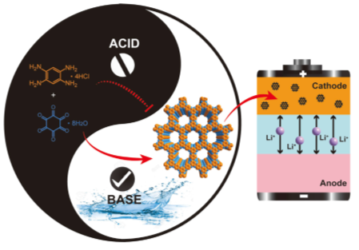
Scientific Achievement
Foundry staff reported a bottom-up approach to synthesizing crystalline holey graphene with 1.2 nm-sized pores periodically inserted in the two-dimensional (2D) layers, which is amongst the highest-performing organic cathode materials for lithium-ion batteries (LIBs).
Significance and Impact
For the first time, nanopores with molecular precision have been controllably incorporated into graphitic 2D layers and directly visualized by TEM. The synthetic protocol opens the door to a wide array of functional materials for clean energy applications.
Research Details
- The team discovered and validated the unusual dynamic character of C=N bonds in an aromatic ring system under basic aqueous conditions.
- The team then synthesized a fully-fused, nitrogen-rich aromatic 2D graphitic framework with periodic pores connected via hexaazatrinaphthalene (HATN) nodes. HATN has a high lithiation capacity, ideal for use in Li-ion batteries.
- Comprehensive chemical, structural, topographical, optical, electrical, and electrochemical characterization, matched with simulations, definitively illustrated the high crystallinity and in-plane pore structure of the graphitic framework and its utility as a cathode material for LIBs.

